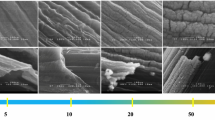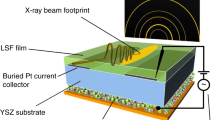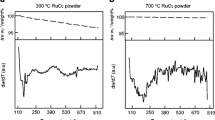Abstract
In this study, near ambient pressure X-ray photoelectron spectroscopy (NAP-XPS) is applied to investigate an electrochemical cell consisting of a rhodium thin film catalyst supported on an yttria-stabilized zirconia (YSZ) solid electrolyte under various ethylene-oxygen reaction mixtures. The aim of the study is twofold: first to show how the surface oxidation state of the Rh catalyst is correlated with the reactants feed composition and the temperature, and second, to reveal the effect of the anodic polarization on the stability of Rh oxides and the implications on the electrochemical promotion of catalysis. It is clearly shown that even under reducing conditions part of the Rh electrode remains oxidized at temperatures up to 250 °C. Reduction of the oxide can take place by increasing the temperature under C2H4 excess, something which is not happening under oxidizing reaction mixtures. Moreover, anodic polarization, i.e. oxygen ion supply to the surface, facilitates reduction of oxidized Rh electrodes over a broad range of ethylene–oxygen reaction mixtures. Remarkably, under mildly reducing conditions a stable ultrathin Rh surface oxide film forms over metallic Rh. This surface Rh oxide film (RhOx) is associated to higher cell currents, counterintuitive to the case of bulk Rh oxides (Rh2O3).






Similar content being viewed by others
References
Ladas S, Kennou S, Bebelis S, Vayenas CG (1993) Origin of non-faradaic electrochemical modification of catalytic activity. J Phys Chem 97:8845–8848. https://doi.org/10.1021/j100137a004
Vayenas CG (2013) Promotion, electrochemical promotion and metal-support interactions: their common features. Catal Lett 143:1085–1097. https://doi.org/10.1007/s10562-013-1128-x
Vayenas CG, Bebelis S, Pliangos C et al (2001) Electrochemical activation of catalysis: promotion, electrochemical promotion, and metal-support interactions. https://doi.org/10.1007/b115566
Vayenas CG, Koutsodontis CG (2008) Non-faradaic electrochemical activation of catalysis. J Chem Phys. https://doi.org/10.1063/1.2824944
Katsaounis A (2010) Recent developments and trends in the electrochemical promotion of catalysis (EPOC). J Appl Electrochem 40(5):885–902
Vayenas CG (2011) Bridging electrochemistry and heterogeneous catalysis. J Solid State Electrochem 15:1425–1435. https://doi.org/10.1007/s10008-011-1336-5
Tsiplakides D, Balomenou S (2009) Milestones and perspectives in electrochemically promoted catalysis. Catal Today 146:312–318. https://doi.org/10.1016/j.cattod.2009.05.015
Vernoux P, Lizarraga L, Tsampas MN et al (2013) Ionically conducting ceramics as active catalyst supports. Chem Rev 113:8192–8260. https://doi.org/10.1021/cr4000336
Van Herle J, McEvoy a J (1994) Oxygen diffusion through silver cathodes for solid oxide fuel cells. J Phys Chem Solids 55:339–347. https://doi.org/10.1016/0022-3697(94)90230-5
Adler SB (2004) Factors governing oxygen reduction in solid oxide fuel cell cathodes. Chem Rev 104:4791–4843. https://doi.org/10.1021/cr020724o
Fleig J, Jamnik J (2005) Work function changes of polarized electrodes on solid electrolytes. J Electrochem Soc 152:E138. https://doi.org/10.1149/1.1862479
Baranova EA, Thursfield A, Brosda S et al (2005) Electrochemically induced oscillations of C2H4 oxidation over thin sputtered Rh catalyst films. Catal Lett 105:15–21. https://doi.org/10.1007/s10562-005-7999-8
Baranova EA, Thursfield A, Brosda S et al (2005) Electrochemical promotion of ethylene oxidation over Rh catalyst thin films sputtered on YSZ and TiO2/YSZ supports. J Electrochem Soc 152:E40–E49. https://doi.org/10.1149/1.1839511
Brosda S, Badas T, Vayenas CG (2011) Study of the mechanism of the electrochemical promotion of Rh/YSZ catalysts for C2H4 oxidation via AC impedance spectroscopy. Top Catal 54:708–717. https://doi.org/10.1007/s11244-011-9679-9
De Lucas-Consuegra A, González-Cobos J, Carcelén V et al (2013) Electrochemical promotion of Pt nanoparticles dispersed on a diamond-like carbon matrix: a novel electrocatalytic system for H2 production. J Catal 307:18–26. https://doi.org/10.1016/j.jcat.2013.06.012
Fortunato MA, Princivalle A, Capdeillayre C et al (2014) Role of lattice oxygen in the propane combustion over Pt/Yttria-stabilized zirconia: isotopic studies. Top Catal 57:1277–1286. https://doi.org/10.1007/s11244-014-0293-5
Hajar YM, Patel KD, Tariq U, Baranova EA (2017) Functional equivalence of electrochemical promotion and metal support interaction for Pt and RuO2 nanoparticles. J Catal 352:42–51. https://doi.org/10.1016/j.jcat.2017.05.001
Vayenas CG, Bebelis S, Ladas S (1990) Dependence of catalytic rates on catalyst work function. Nature 343:625–627. https://doi.org/10.1038/343625a0
Pliangos C, Yentekakis IV, Verykios XE, Vayenas CG (1995) Non-faradaic electrochemical modification of catalytic activity. 8. Rh-catalyzed C2H4 oxidation. J Catal 154:124–136. https://doi.org/10.1006/jcat.1995.1154
Pliangos C, Yentekakis IV, Papadakis VG et al (1997) Support-induced promotional effects on the activity of automotive exhaust catalysts: 1. The case of oxidation of light hydrocarbons (C2H4). Appl Catal B Environ 14:161–173. https://doi.org/10.1016/S0926-3373(97)00020-9
Neophytides SGG, Zafeiratos S, Kennou S (2000) XPS characterization of the electrochemically generated O species on a Au electrode evaporated on Y2O3-stabilized ZrO2 (100). Solid State Ionics 136:801–806. https://doi.org/10.1016/s0167-2738(00)00542-7
Stoerzinger KA, Hong WT, Crumlin EJ et al (2015) Insights into electrochemical reactions from ambient pressure photoelectron spectroscopy. Acc Chem Res 48:2976–2983. https://doi.org/10.1021/acs.accounts.5b00275
Paloukis F, Papazisi KM, Balomenou SP et al (2017) In situ X-ray photoelectron spectroscopy study of complex oxides under gas and vacuum environments. Appl Surf Sci 423:1176–1181. https://doi.org/10.1016/j.apsusc.2017.06.219
Toghan A, Arrigo R, Knop-Gericke A, Imbihl R (2012) Ambient pressure X-ray photoelectron spectroscopy during electrochemical promotion of ethylene oxidation over a bimetallic Pt-Ag/YSZ catalyst. J Catal 296:99–109. https://doi.org/10.1016/j.jcat.2012.09.006
Carberry JJ (1976) Chemical and catalytic reaction engineering. McGraw-Hill, New York
Knop-Gericke A, Kleimenov E, Hävecker M et al (2009) X-ray photoelectron spectroscopy for investigation of heterogeneous catalytic processes. Adv Catal 52:213–272. https://doi.org/10.1016/s0360-0564(08)00004-7
Papaefthimiou V, Shishkin M, Niakolas DK et al (2013) On the active surface state of nickel-ceria solid oxide fuel cell anodes during methane electrooxidation. Adv Energy Mater 3:762–769. https://doi.org/10.1002/aenm.201200727
Papaefthimiou V, Niakolas DK, Paloukis F et al (2017) Operando observation of nickel/ceria electrode surfaces during intermediate temperature steam electrolysis. J Catal 352:305–313. https://doi.org/10.1016/j.jcat.2017.06.005
Tanuma S, Powell CJ, Penn DR (1993) Calculations of electron inelastic mean free paths. Surf Interface Anal 21:165–176. https://doi.org/10.1002/sia.740210302
Yeh JJ, Lindau I (1985) Atomic subshell photoionization cross sections and asymmetry parameters: 1 < Z < 103. At Data Nucl Data Tables 32:1–155. https://doi.org/10.1016/0092-640X(85)90016-6
Powell CJJ, Jablonski A (2010) Progress in quantitative surface analysis by X-ray photoelectron spectroscopy: current status and perspectives. J Electron Spectros Relat Phenom 178:331–346. https://doi.org/10.1016/j.elspec.2009.05.004
Blomberg S, Lundgren E, Westerström R et al (2012) Structure of the Rh2O3(0001) surface. Surf Sci 606:1416–1421. https://doi.org/10.1016/j.susc.2012.05.004
Blomberg S, Westerström R, Martin NM et al (2014) A high pressure X-ray photoelectron spectroscopy study of oxidation and reduction of Rh(100) and Rh nanoparticles. Surf Sci 628:153–158. https://doi.org/10.1016/j.susc.2014.06.009
Kibis LS, Stadnichenko AI, Koscheev SV et al (2016) XPS study of nanostructured rhodium oxide film comprising Rh4+ species. J Phys Chem C 120:19142–19150. https://doi.org/10.1021/acs.jpcc.6b05219
Grass ME, Zhang Y, Butcher DR et al (2008) A reactive oxide overlayer on rhodium nanoparticles during CO oxidation and its size dependence studied by in situ ambient-pressure X-ray photoelectron spectroscopy. Angew Chem Int Ed 47:8893–8896. https://doi.org/10.1002/anie.200803574
Dri C, Africh C, Esch F et al (2006) Initial oxidation of the Rh(110) surface: ordered adsorption and surface oxide structures. J Chem Phys. https://doi.org/10.1063/1.2345058
Marot L, Mathys D, Temmerman G, De Oelhafen P (2008) Characterization of sub-stoichiometric rhodium oxide deposited by magnetron sputtering. Surf Sci 602:3375–3380. https://doi.org/10.1016/j.susc.2008.09.012
Paloukis F, Papazisi KM, Dintzer T et al (2017) Insights into the surface reactivity of Cermet and Perovskite electrodes in oxidizing, reducing, and humid environments. ACS Appl Mater Interfaces 9:25265–25277. https://doi.org/10.1021/acsami.7b05721
Parmigiani F, Depero LE, Sangaletti L, Samoggia G (1993) An XPS study of yttria-stabilised zirconia single crystals. J Electron Spectros Relat Phenomena 63:1–10. https://doi.org/10.1016/0368-2048(93)85010-I
Gustafson J, Mikkelsen A, Borg M et al (2004) Self-limited growth of a thin oxide layer on Rh(111). Phys Rev Lett 92126101–126102. https://doi.org/10.1103/PhysRevLett.92.126102
Doh WHWH, Papaefthimiou V, Dintzer T et al (2014) Synchrotron radiation X-ray photoelectron spectroscopy as a tool to resolve the dimensions of spherical core/shell nanoparticles. J Phys Chem C 118:26621–26628. https://doi.org/10.1021/jp508895u
Mittendorfer F (2010) Low-dimensional surface oxides in the oxidation of Rh particles. J Phys Condens Matter 22:393001. https://doi.org/10.1088/0953-8984/22/39/393001
Katsaounis A, Nikopoulou Z, Verykios XE, Vayenas CG (2004) Comparative isotope-aided investigation of electrochemical promotion and metal-support interactions: 2. CO oxidation by 18O2 on electropromoted Pt films deposited on YSZ and on nanodispersed Pt/YSZ catalysts. J Catal 226:197–209. https://doi.org/10.1016/j.jcat.2004.05.009
Vayenas CG, Bebelis S, Yentekakis IV, Lintz HG (1992) Non-faradaic electrochemical modification of catalytic activity: a status report. Catal Today 11:303–438. https://doi.org/10.1016/0920-5861(92)80002-5
Assmann J, Crihan D, Knapp M et al (2005) Understanding the structural deactivation of ruthenium catalysts on an atomic scale under both oxidizing and reducing conditions. Angew Chem Int Ed 44:917–920. https://doi.org/10.1002/anie.200461805
Hendriksen BLM, Frenken JWM (2002) CO oxidation on Pt(110): scanning tunneling microscopy inside a high-pressure flow reactor. Phys Rev Lett. https://doi.org/10.1103/PhysRevLett.89.046101
Danilovic N, Subbaraman R, Chang KC et al (2014) Using surface segregation to design stable Ru-Ir oxides for the oxygen evolution reaction in acidic environments. Angew Chem Int Ed 53:14016–14021. https://doi.org/10.1002/anie.201406455
Saveleva VA, Wang L, Luo W et al (2016) Uncovering the stabilization mechanism in bimetallic ruthenium-iridium anodes for proton exchange membrane electrolyzers. J Phys Chem Lett 7:3240–3245. https://doi.org/10.1021/acs.jpclett.6b01500
Acknowledgements
We thank AC department of FHI and in particular M. Hävecker and A. Knop-Gericke for the opportunity to use the ISISS beamline and HZB for the allocation of synchrotron radiation beamtime. We acknowledge the support of Dr. T. Dintzer for the SEM images and Dr. Y.T. Law during the beamtime measurements.
Author information
Authors and Affiliations
Corresponding author
Rights and permissions
About this article
Cite this article
Katsaounis, A., Teschner, D. & Zafeiratos, S. The Effect of Polarization and Reaction Mixture on the Rh/YSZ Oxidation State During Ethylene Oxidation Studied by Near Ambient Pressure XPS. Top Catal 61, 2142–2151 (2018). https://doi.org/10.1007/s11244-018-1073-4
Published:
Issue Date:
DOI: https://doi.org/10.1007/s11244-018-1073-4




